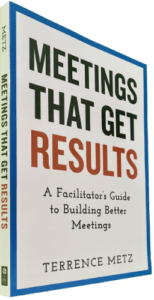Your regularly scheduled staff meeting may not be an event that your staff anticipates. Some employees might prefer having a root canal. At least with a root canal, pain medication is provided. You can lead better staff meetings, and quicker too, and here’s how.
There are good meetings, and there are long meetings, but there aren’t many good, long meetings. Why are many staff meetings hated and what can you do about yours? Based on Agile’s Daily Scrum, this procedure encourages self-advancing teams to meet briefly. Time-boxed to 15 minutes in duration, you may also call it a daily stand-up, a weekly roll call, or a monthly huddle. This approach assuredly provides better staff meetings.
Have a Clear Purpose and Scope for Your Staff Meeting
People complain that they remain uncertain about the purpose of their staff meeting, even when it has concluded. Many managers assume that staff value developing an understanding of WHAT other staff members are doing. Many managers assume that staff will support one another when someone needs assistance. You know what happens when you assume.
Since the purpose of the normal staff meeting rotates around sharing, emphasize WHY sharing is important. It’s not that we want bright and informed employees, so much as we want employees making more informed decisions. We seek decisions that support one another to help us reach our goals and objectives. We seek to change behavior when the meeting has concluded, to further enhance our efforts to excel. Be clear that you are seeking change, NOT simply information exchange.
If nothing has changed, then your staff meeting could be a waste of time. If something has changed, let’s ensure we understand WHAT has changed, and more importantly, WHY. Build consensus around the rationale supporting the change, not only the change action itself. If something needs to change, it may be optimal to have it change much sooner than when you schedule your regular staff meeting.
The 3-Question Approach
Use the trivium formula of “yesterday, today, and tomorrow” (past, present, future) to modify the questions listed here for your needs.
The classic three questions (with alternatives) are as follows:
1. What did you complete yesterday? (What did I accomplish yesterday?)
2. What are you focused on today? (What will I do today?)
3. What impediments are you facing that we might help you with? (What obstacles are impeding my progress?)
Here’s a motivational version:
1. What did you do to change the world yesterday? (What did you accomplish since we last met?)
2. What are you going to crush today? (What are you working on until our next meeting?)
3. What obstacles are you going to blast through that may be unfortunate enough to be standing in your way? (What is getting in your way or keeping you from doing your job?)
Convert Your Staff Meeting into a Standing Meeting
The original idea of a meeting that repeats itself the same date and time weekly, monthly, or quarterly, made that type of meeting to be called a “standing meeting.” The term originally does not only imply that it stands at the same time on the calendar, it also implies that there is no need to sit down.
People should stand at most staff meetings, and get done faster. The depth of information sharing requires that we all understand WHAT each other is doing. However, we probably don’t need to know HOW it’s going to be done. When someone goes ”deep into the weeds” they are probably talking about HOW, not WHAT they plan to do.
We need to know for example that you “are going to pay the bills” but we don’t need to know that you are writing cheques or sending electronic funds transfers. We rely on you to execute the best way to get it done. Keep in mind the difference between WHAT and HOW is relatively simple. What you do (e.g., “pay bills”) remains abstract while HOW you do it (“write cheques”) becomes concrete.
When you impose the standing (rather than sitting) rule for your staff meetings, more people will stop talking when they have covered WHAT they are doing. They will spare us the gory details and time wasted about HOW they are going to do it. For the rare circumstance when sharing the HOW is important, participants may freely ask (“How are you going to do that?”). But as long as participants remain standing, people will stay focused, and your staff meeting will provide the change you seek, only much faster than you currently realize.
Develop Consensually Agreed Upon Output from Your Staff Meeting
Did you ever leave a staff meeting and ask “What did we agree on in there?” Worse yet, have you experienced more than one answer to that question? Perhaps contradictory answers?
Do not assume that your staff has extracted the same learnings and takeaways. Do something to facilitate and confirm that we are all agreeing on the same change and a similar course of action. All too often people leave a staff meeting and begin acting in ways that contradict one another. WHY? Because we have done nothing to facilitate and ensure common understanding.
Build an agreement at the end of your staff meeting that reflects new actions learned as a result of the staff meeting. Again, if the new actions are thin and far between, perhaps we need fewer or quicker staff meetings. That brings us to our final point . . .
Final Comments
Use the same technique for your weekly, biweekly, or monthly staff meetings. Although not exhaustive, scope creep is prevented when progress reports are restricted to yesterday (past), today (present), and obstacles (future). Additionally, standing rather than sitting ensures that staff meetings remain brief, discourages wasted time, and keeps participants in scope.
NOTE: This approach does not provide the time and place to solve problems. Rather, the Staff Meeting makes the team aware of what people are working on. If detailed support is required, a separate meeting with appropriate participants is arranged after the meeting. Topics that require additional attention should always be deferred until every team member has reported.
______
Don’t ruin your career by hosting bad meetings. Sign up for a workshop or send this to someone who should. MGRUSH workshops focus on meeting design and practice. Each person practices tools, methods, and activities daily during the week. Therefore, while some call this immersion, we call it the road to building high-value facilitation skills.
Our workshops also provide a superb way to earn up to 40 SEUs from the Scrum Alliance, 40 CDUs from IIBA, 40 Continuous Learning Points (CLPs) based on Federal Acquisition Certification Continuous Professional Learning Requirements using Training and Education activities, 40 Professional Development Units (PDUs) from SAVE International, as well as 4.0 CEUs for other professions. (See workshop and Reference Manual descriptions for details.)
Want a free 10-minute break timer? Sign up for our once-monthly newsletter HERE and receive a free timer along with four other of our favorite facilitation tools.

Terrence Metz, president of MG RUSH Facilitation Training, was just 22-years-old and working as a Sales Engineer at Honeywell when he recognized a widespread problem—most meetings were ineffective and poorly led, wasting both time and company resources. However, he also observed meetings that worked. What set them apart? A well-prepared leader who structured the session to ensure participants contributed meaningfully and achieved clear outcomes.
Throughout his career, Metz, who earned an MBA from Kellogg (Northwestern University) experienced and also trained in various facilitation techniques. In 2004, he purchased MG RUSH where he shifted his focus toward improving established meeting designs and building a curriculum that would teach others how to lead, facilitate, and structure meetings that drive results. His expertise in training world-class facilitators led to the 2020 publication of Meetings That Get Results: A Guide to Building Better Meetings, a comprehensive resource on effectively building consensus.
Grounded in the principle that “nobody is smarter than everybody,” the book details the why, what, and how of building consensus when making decisions, planning, and solving problems. Along with a Participant’s Guide and supplemental workshops, it supports learning from foundational awareness to professional certification.
Metz’s first book, Change or Die: A Business Process Improvement Manual, tackled the challenges of process optimization. His upcoming book, Catalyst: Facilitating Innovation, focuses on meetings and workshops that don’t simply end when time runs out but conclude with actionable next steps and clear assignments—ensuring progress beyond discussions and ideas.




